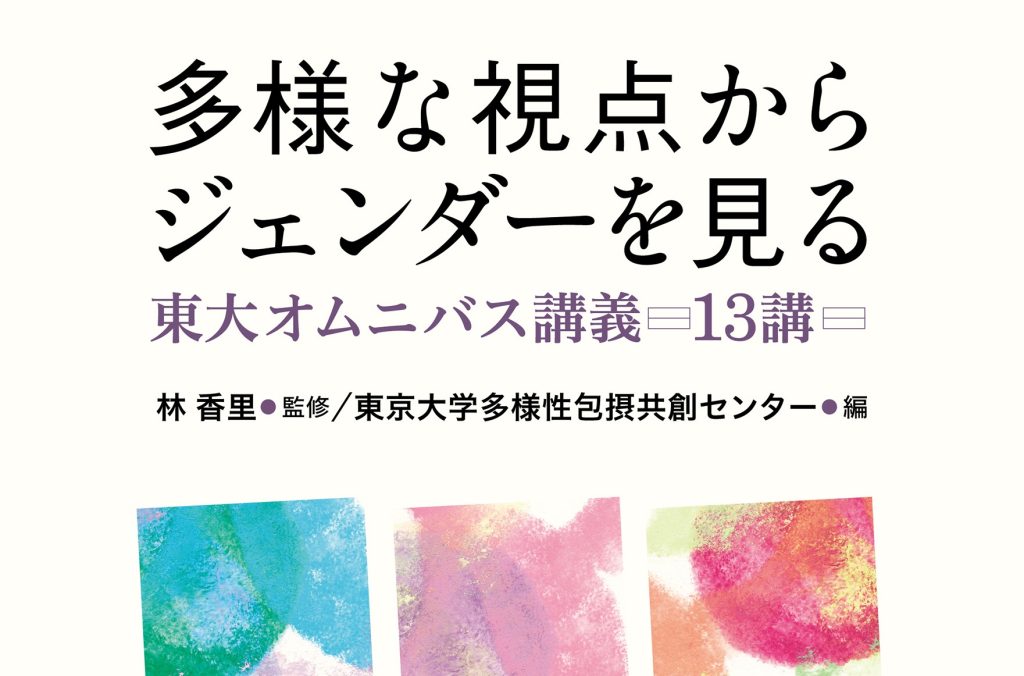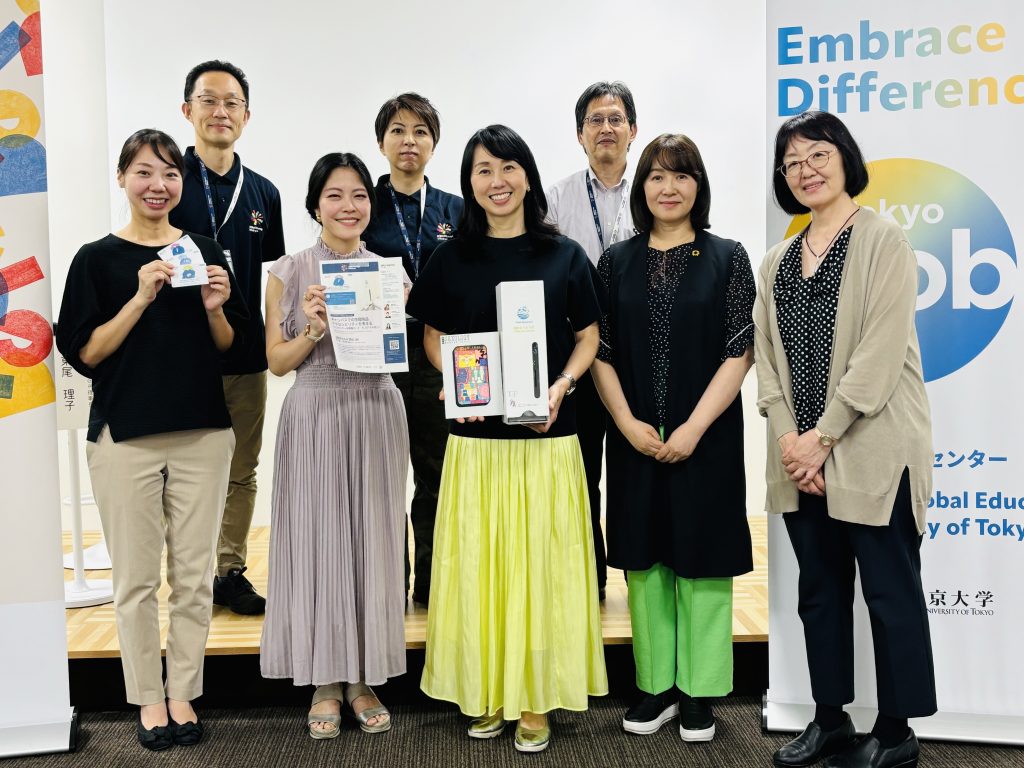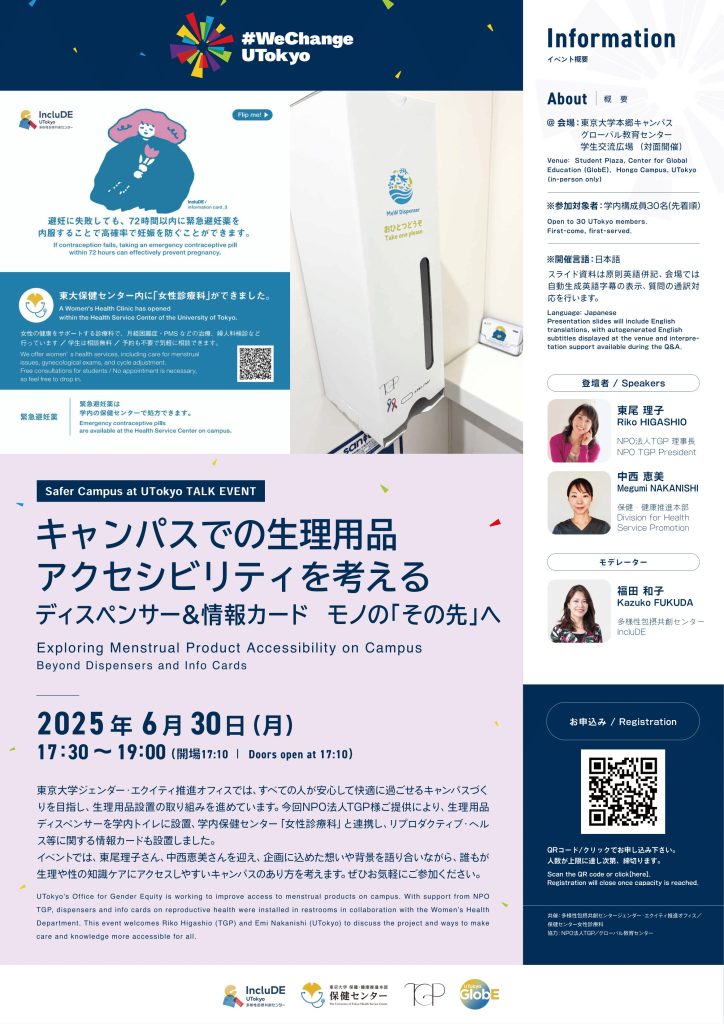Professor Hoshi, Dean of the Graduate School of Economics, gave the opening remarks.
Welcome to the Faculty Development seminar, titled “Career Development Support for Women in Academia: Experiences in the U.S. and Europe.” The University of Tokyo has reconfirmed the importance of diversity, especially gender. Under the leadership of President Fujii, we have renewed the effort to improve diversity on campus. UTokyo Compass, which lays out the guiding principles of the University of Tokyo, is subtitled “into a sea of diversity,” and stated that “UTokyo will further promote dialogue that is open to diversity and will work hand-in-hand with society to create an ideal vision for a shared future.”
In terms of gender equity, we held a kickoff event for an initiative called #WeChange. It calls for improving awareness and understanding of gender inequality issues, and promoting women researchers, including graduate students, faculty, and administrative staff on campus.
Today’s seminar is a part of this effort, and we have invited two great scholars from the U.S. and Europe, Professor Mary C. Brinton from Harvard University and Professor Renée Adams from the University of Oxford. They will share ideas and experiences from American and European academic institutions, which began the effort to promote diversity much earlier than we did.
Message from Masako Mori, Member of the House of Councilors, Special Advisor to the Prime Minister
Councilor Mori gave us a video message at the beginning of the seminar.

I am pleased to announce the opening of this seminar. I am looking forward to hearing about women’s active participation and career development support for female researchers from Professor Brinton and Professor Adams. I have heard that Professor Adams has conducted research and has trained female researchers, and I hope her speech will encourage and inspire young female researchers in Japan. Professor Brinton has had interactions with the Japanese government, and her book Japan Tied Up in Knots: Can the Norms Leading to Population Decline Be Broken? has not only impressed me, but also men who have not been interested in gender inequality before. Now is the chance to bring change to the situation in Japan. I hope that the University of Tokyo will lead the country in making changes and playing a larger role in the world.
Lecture by Professor Mary C. Brinton, Director, Reischauer Institute of Japanese Studies, Harvard University: “Achieving Gender Parity in Academia: A View from the U.S.“
The total percentage of female faculty at PhD-granting institutions in the U.S. is 42.3%, which is not a low number. But when we limit the number to only those in tenured or tenure-track positions, the percentage is considerably lower. So although we have made a lot of progress, we have not yet reached gender equity in terms of the percentages of women and men in faculty positions.
The discussion of diversity in the U.S. includes gender and ethnic minorities. Therefore, I’d like to talk a little about that, although today’s focus is on gender issues.
“WHAT TYPES OF DIVERSITY EFFORTS ARE POSSIBLE?”


Research on faculty diversity efforts conducted by Professor Frank Dobbin, which included 600 medium and large private and public colleges and universities in the U.S., explored the effects of the programs above on the percentages of female faculty members. His study produced several findings.
- Diversity training at universities has not changed the percentage of white or black female professors and has had a negative effect on the percentage of Hispanic women. In short, it has not been effective. Similarly, mandatory harassment training has had a negative effect on the percentage of black women but no effect on the percentage of other women. The reason for these mixed and negative results may well be that people prefer not to be told that they are biased, and doing so will not change the situation.
- Harassment grievance procedures, civil rights grievance procedures
These did not have significant positive effects. In fact, they produced negative effects on the percentages of Hispanic and Asian female faculty.
- Programs (including open recruitment) that enhance career development
During the past several decades, faculty recruitment moved from being based on the “old boys’ network” to open searches. When departments select graduate students and recruit new faculty, universities require them to try to solicit a diverse group of candidates and to make the selection decisions with this in mind.
- Task forces
Having task forces that look at the recruitment and promotion of women or underrepresented minority ethnic groups has a small positive effect on the percentages of white female faculty and a larger positive effect on the percentages of minority women.
- Work-life balance programs
Most leading universities give teaching relief to new parents. Harvard has emergency childcare services. It also has on-campus subsidized childcare facilities, used by half of the faculty who have young children.
Looking at these types of diversity efforts, diversity programs and grievance procedures have had no effects or sometimes even negative effects. Getting academic deans involved in the career development of underrepresented groups, creating a task force, and creating programs that extend work-life balance to men as well as women seem to have a positive influence on the percentages of female faculty.

Let me tell a quick story. When I was working at the University of Chicago right out of graduate school, it was often the case that I was in a room filled almost entirely with older male faculty. I was shy and anxious about doing well academically at the time. But the department chair conducted meetings in a way that was very helpful for younger faculty such as me. He turned to either his right or his left and asked the faculty member next to him to begin the discussion by stating their point of view on the decision we were going to make as a faculty. Then the next faculty member at the table would speak, and we would continue around the table in order. By conducting the meeting in this way, each faculty member was required to speak. This meant that we needed to prepare for the meeting so that we could formulate and articulate our opinions on important decisions. I remember beautiful moments when older faculty members changed their ideas after listening to younger faculty members speak. I carried this custom with me when I moved to Harvard and eventually became the chair of my department.
Several lessons from Harvard Diversifying the faculty takes time
Developing the pipeline of women coming out of graduate school and obtaining faculty positions takes time. The percentage of women in tenured faculty positions at Harvard has increased from 19% to 29% in the past 18 years, and the percentage of women in tenure-track positions has increased from 35% to 45%.
It is important to focus on new hires
New hires are where new talent is coming from, and raising up the new generation is important. When hiring, we conduct open searches and review a large number of applicants. There are many “checks and balances” in the dean’s office and higher up in the university to make sure that we are making excellent choices and are considering the diversity in the applicant pool.
Diversify university leadership
There are currently eight female academic deans at Harvard, which allows for meaningful change to come from the top. I believe this would have a similar effect in Japan, and that men as well as women will benefit from this.
Diversify the Board of Trustees
In 1987, there were no female members in the Harvard Corporation (Board of Trustees), but in 2022 half of them were female. This is a huge change.
What is the pipeline?
60% of university students in the U.S. are female. Some American universities are having trouble keeping a gender balance in their student body because there are so many highly qualified female applicants. For example, in 2021, more women than men applied to Harvard. I know that only 20% of undergraduate students at the University of Tokyo are women (and only 20% of the applicants are women). That is where change should start. Increasing the number of female undergraduate students creates the pipeline that will lead to more women in faculty positions.
Lecture by Renée Adams, Professor of Finance Saïd Business School, University of Oxford : “What’s good for women is good for science.”
I am a Governance scholar, and I have focused on power balance, transparency, women on boards, in finance, in academia, and in art. I launched FEW (finance and economics women) in Australia.
Some evidence that diversity is important for science
Based on data on top 2% of scientist by citations worldwide across fields and countries in 2019, data on gender-equality of the country and the field, the more women participate in the work force, the more top female scientists there are. Also, GDP, gender gap in math scores, and field fixed effects had a positive correlation with scientific achievements. On the other hand, the higher the field-specific ability beliefs are, the less top female scientists there were. This show that female scientists migrate to more gender-equal countries and produce relatively more paper in a more equal environment.

I proposed to do a professional culture survey of members of the American Finance Association. It took three years to carry it out, which shows that making changes is not easy. We measured job satisfaction, freedom of expression, and the allocation of human capitals, such as whether people leave a position or avoid a particular research area. The results showed that women, those who experienced discrimination or have childcare were more likely to feel that they felt the department repressed free expression of ideas. Women were more likely to leave a position due to unfair treatment, but those with childcare duties were less likely to leave, most likely because it is hard for them to move. In addition, women or those who experienced discrimination were more likely to avoid research area due to unfair treatments. Overall, women were overwhelmingly more likely to have negative experiences. Fostering a culture that is more open to diversity will lead to more expression of ideas, more active engagement in research areas, and more satisfied and productive members.
What I have learned
In the profession, I learned that there is little appetite for funding research in this area, and it is hard to publish. Also, there is an excessive belief in efficient markets. Many think that if women were good enough, women would be successful because markets work that way. This also leads to the idea that discrimination does not exist, because based on the idea of markets, the person with better talents would always be more successful, regardless of their backgrounds. There are too many quick fixes and too little thoughtfulness. Many universities have diversity “quotas” that are often imposed from above. They create measurable backlash against women. People begin to tell stories about women being treated unfairly better than men with no evidence, and negatively affects the situation.
The Way Forward
Improving country-level gender-equality is important. Also, institutional actions such as accommodating childcare and maternity leave, taking action to address unfair treatment within the institution, fostering collegiality, diversifying seminars series, good governance, or promoting transparency and accountability will help. Science also plays a significant role, so we should have more funding in the gender equality area and create forums for dialogue and exchange of ideas in the area. Data shows that only half of the faculty members of top research universities in the U.S. feels comfortable raising issues that may affect their performance review or professional advancement. There is need for more dialogue.
Paraphrasing French and Williams INYT, “The road to a better, more genuinely empathetic and just society is narrowly wended through dialogue, patience, persuasion, generosity, and truth/accuracy.”

General remarks and closing remarks from Kaori Hayashi, Executive Vice president (Diversity and Global affairs), the University of Tokyo
Professor Brinton showed us how American universities, especially Harvard, have made efforts to increase the number of female faculty members and provided supports to them, and which measures were more effective. I wonder how far cultural components play a role in terms of respecting diversity and increasing female faculty, so I’d like to conduct a comparative survey between the U.S. and Japan in the future. Professor Adams pointed out the significance of diversity in research and education and illustrated the good practices. Her remark that the expectation of brilliance works negatively on gender diversity confirmed what I have experienced here at the University of Tokyo. It is exactly what is happening right now, and we must change it. Overall, your message “What’s good for women is also good for science” brought home everybody the importance of achieving gender diversity on campus. Hearing that there are still gender issues in the U.S. and Europe makes me have mixed feelings, as it reminds us that increasing the number of female researchers is far from an easy task. At the same time, your remarks made me realize that we are not alone in the endeavor of increasing the diversity in our community, and there are opportunities for us to collaborate to achieve our common cause.
This academic year, the University of Tokyo has launched a comprehensive gender reform campaign called “UTokyo Gender Equity Initiative #WeChange.” As many of you know, we have been doing poorly in terms of gender balance within our community. There has been some progress, but the numbers still don’t look good. President Fujii made 4 out of 9 Executive Vice Presidents female, but the percentage of female faculty member, professors, and students are still low.

#WeChange consists of three phases. The first and the most important action would be to change the institutional culture by raising awareness through mandatory education to faculty. We will also ask the first- and second-year students to watch videos on issues such as gender bias and sexual consent. From today’s lecture, I heard this can work negative but I’m not sure in the Japanese context whether unconscious bias training program necessarily work negative on us. We are at the stage where we have to be aware how important it is to have diverse members here at the University of Tokyo. The second step is to increase the number of female researchers. It aims to empower young female researchers by providing financial supports, leadership skills, and work-life-balance support. The third phase is to enhance career development. Our target is 25% of female researchers by 2027, based on a careful simulation. This might seem like a modest number, but given the current situation, it is a challenging goal. We set a target, and we will also combine a dialogue committee to talk about fiver-year plan, which is a big step forward for us. To achieve this goal we will provide subsidies, to hire female junior professors and considering creating a position called role-model hires. I’d like to end with a note of optimism.
We have already seen significant improvement in gender awareness. I would like to think that even though belatedly, we are at the threshold of change. I hope to push for real and fundamental changes in our institutional culture, so that we may create a campus that is more open to dialogue, diverse values, and that is accountable for every member of the university community. This is the only path for us to achieve global excellence in research and education.
Report/Student Writer
Wakana Inumaru(B3, Faculty of Medicine)
Edit/Photo
Office for Gender Eqality, the University of Tokyo.



